A Comparison of Liquid Latex and Tape for Removing Surface Debris to Improve Fingerprint Quality (Grossi 2020)

FSc Anthro almuna Isabella Grossi joins our list of students published in Identification Canada.
Her article, A Comparison of Liquid Latex and Tape for Removing Surface Debris to Improve Fingerprint Quality, was released in the September 2020 issue, and puts into print Isabella's 481 Internship research, which she completed under the supervision of Jaclyn Slaney and Cameron Power of the Toronto Police Forensic Identification Services.
The article is available to read online for Canadian Identification Society members at https://www.cis-sci.ca/journals.
Job security and the promotion of workers’ wellbeing in the midst of the COVID-19 pandemic (Pacheco 2020)

Forensic science alum and PhD candidate Tyler Pacheco recently published an article about Canadian workers and their response to social distance measure during the current global pandemic. Due to the coronavirus (COVID-19) crisis, workplaces have had to make significant alterations in the way they conduct business.
This, in addition to the current financial instability, may put workers at risk of experiencing job insecurity and, in turn, lower wellbeing. Job insecurity is a key determinant of wellbeing, but little is known on how it is impacted by public health crises, and more specifically how it relates to workers’ positive and negative wellbeing in the midst of a pandemic.
The article can be accessed through the International journal of Wellbeing.
The Use of Liquid Latex to Recover Latent Fingerprints that are Covered in Debris from Exterior Glass Surfaces of Vehicles (Kapsa 2020)

Recent alumna Cassandra Kapsa recently published an article, based on her FSC481 internship research, in the Journal of Forensic Sciences titled The Use of Liquid Latex to Recover Latent Fingerprints that are Covered in Debris from Exterior Glass Surfaces of Vehicles.
The purpose of her research was to determine if latent fingerprints, deposited on exterior glass surfaces of vehicles (and subsequently covered in debris), could be recovered. Cassandra's research is significant, because this technique has the potential to aid in identifying possible person(s) of interest at a crime scene involving a vehicle in different conditions. The exterior glass surfaces of vehicles are of specific interest because they are a common area of the vehicle that a suspect may be in contact with.
Cassandra's research also contributes to an expanding literature of the application of liquid latex in a forensic context.
The article can be accessed online through the Wiley Online Library.
Examining growth rates of Scopulariopsis brevicaulis on decomposing porcine remains (Braga 2020)
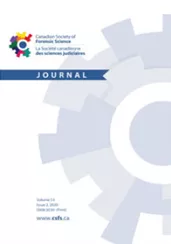
Have you ever wondered what fungal growth and decomposition rates can tell us about human deposition? Of course you have!
Recent alumna Allana Braga, and co-authors Forensic Identification instructor Det. Cst. Wade Knaap and Dr. Richard Summerbell, recently published in the Canadian Society of Forensic Science Journal.
The purpose of this study was to examine growth rates for the filamentous fungus Scopulariopsis brevicaulis on decomposing pig remains in relation to three controlled temperatures. This study was performed by inoculating porcine tissue samples retrieved from the same source, then placing the samples into three controlled environments to examine changes over a month. This study was intended to develop a photographic and quantifiable chronology of fungal growth that can be used as a reference by investigative personnel interested in utilizing mycological evidence in death investigations.
The article can be accessed online through Taylor & Francis Online.
Providing this novel information to the inadequately studied discipline of forensic mycology is intended to help establish the credibility of this field. These efforts will aid in interpreting post-mortem intervals for cadavers experiencing fungal growth in controlled indoor environments.
This important research took place in UTM's own Forensic Science Crime Scene House.
Application of Fingerprint Enhancement Reagents Crystal Violet and Amido Black using a household “Slime” Compound (Byrne 2020)

Slime might not be just for summer camps and YouTube channels anymore! Forensic Science recent graduate, Leanne Byrne, spent this past semester investigating the potential of colloidal compounds, combined with reactive agents, in recovering hard to obtain latent (or invisible) fingerprints.
The article, co-authored by Professor Wade Knaap and UTM Chemistry Lab Technician Agata Gapinksa-Serwin, used latent impressions deposited in a depletion series on four adhesive substrates, and bloody impressions on two nonporous substrates to determine the effectiveness of the compound when it contained crystal violet, and amido black, respectively.
The crystal violet compound demonstrated effective enhancement capabilities on the primary depositions of all adhesive substrates,
even after a one week period of storage. To see more about the results, and the potential for how this may change fingerprint development in the future, you can read the full article online at https://www.cis-sci.ca/journals (membership required).
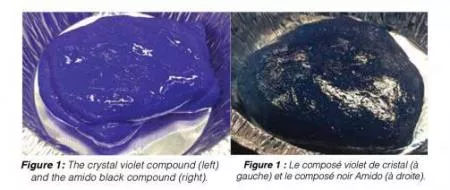
Evaluating the morphological and metric sex of human crania using 3-dimensional (3D) technology (Berezowski 2020)
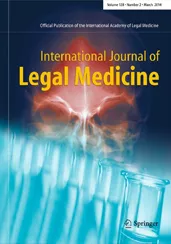

Identifying the skeletal remains of an unidentified individual is a priority for the medico-legal system because identification increases the chances of finding the person responsible and provides closure to the family.
Forensic Science Program alumna Victoria Berezowski (anthropology specialist) recently published an article titled .
This paper, co-authored by program director Dr. Tracy Rogers and professor Eugene Liscio, explored the possibiity of developing a combined morphological and metric cranial sex assessment method using 3D technology that accommodates the medico-legal system, and their use of 3D models facilitates the technological transition to digitally archived skeletal collections.
The article is available to read online through Springer Academic Publishing.
Future development of this method investigation may allow forensic anthropologists to perform relatively easy point-to-point measurements, and quantify traditionally non-quantified traits.
Comparing Leucocrystal Violet, Amido Black, and Acid Yellow to Enhance Bloody Fingerprints (Le Fèvre & Beaudoin 2019)
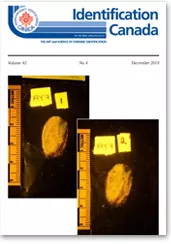

In case you missed it, the December issue of Identification Canada features a cover article by our very own program alum, Charlotte Le Fèvre! Charlotte graduated from the Forensic Anthropology specialist degree in 2019, and is currently completing her Master's degree in Edinburgh.
The article, co-authored with fingerprint expert Alexandre Beaudoin, is titled Comparing Leucocrystal Violet, Amido Black, and Acid Yellow to Enhance Bloody Fingerprints, and expands Charlotte's internship research. This article investigates he optimal method
for enhancing bloody fingerprints, identifying several strengths and weaknesses in key methods of fingerprint development.
This research also takes science to a very real level, using real human blood (instead of a proxy animal sample), with engaging deposition techniques- unlike past research, in which fingerprints "were deposited and then blood was poured onto them, or the fingers were dipped in blood and then the fingerprints were deposited... for this research, the blood was spread on the fingers and then the depletion series was deposited," (Le Fèvre & Beaudoin, 2019).
The article is available to read online for Canadian Identification Society members at https://www.cis-sci.ca/journals.
Breaking the binary: The identification of trans-women in forensic anthropology (Schall 2019)
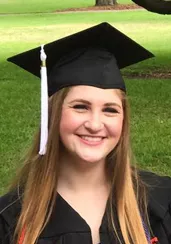
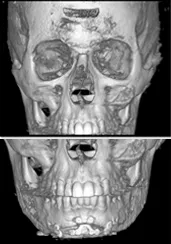
In the cases of transgender and gender non-conforming people, a description of their physical remains, including biological sex, may have little correlation with their social identity, delaying and often confusing the issue of identification. Some transgender individuals have sought to alter their physical appearance in order to better reflect their gender.
Jenna Schall, a UofT Master of Science in Evolutionary Anthropology (specialising in Forensic Anthropology), has just published an article in Forensic Science International, detailing her major research project in the identification of facial feminization surgery (FFS), which involves the reduction and contour of the forehead, chin and jaw, and rhinoplasty to give trans-women smoother, smaller facial features.
The purpose of this research was to examine the impact of FFS on measurement-based methods of cranial sex assessment, such as discriminant function analysis, with the ultimate goal of developing guidelines for correctly recognizing and supporting the identification of trans-women.
The Forensic Science Program is incredibly proud to have one of our students working on bringing such an important and relevant topic into the forefront of human identification. Read Jenna's article online here.
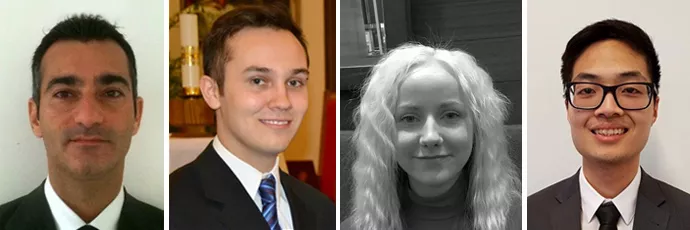
Left to Right: UTM FSC Instructor Eugene Liscio (ai2-3D Forensics, Founder) ; Ph.D. Candidate Patrick Bozek, UTM FSC Alumna and Instructor Helen Guryn (ai2-3D Forensics, Technologist), UTM FSC Alumnus and Internship Supervisor Quan Le (ai2-3D Forensics, Technologist).
A new paper has been published in the Journal of Forensic Sciences, by ai2-3D Forensics, which also happens to be a team of our UTM Forensic Science researchers. This article proposes a new method of analyzing cast-off stains unsing 3D analysis.
From the article's abstract:
Cast-off stains are common patterns found at crime scenes involving blood shedding events. However, the analysis and interpretation of cast-off patterns remains an area lacking tools for crime scene investigators. Analyzing cast-off patterns may allow investigators to interpret the area from where an object may have been swung and thus determine the approximate location of a suspect or victim. This study looked at the position and distribution of cast-off patterns and area of origin as a starting point for the development of a method to analyze cast-off patterns...The observations and analysis from this study were seen to be predictable and repeatable and may provide a possible new method for investigators to interpret cast-off stains.
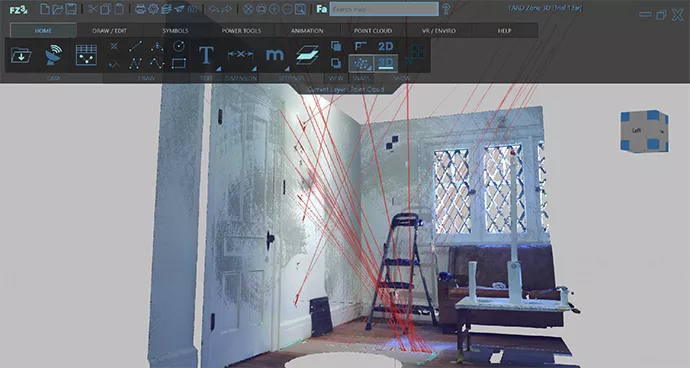
Screen capture from FARO Zone 3D showing results from the “Castanova” rig. Bloodstain trajectories shown in red coming from the wall to the left (x-axis wall). Image from Liscio et al., 2020
doi: 10.1111/1556-4029.14301
Available online at: onlinelibrary.wiley.com
FARO Zone 3D Area of Origin Tools with Handheld 3D Data (Le & Liscio 2019)

Forensic Science Program Alum Quan Le, and FSC Professor Eugene Liscio, have just published a validation paper for the Association of Crime Scene Reconstruction (ACSR) Journal that shows you don't need a laser scanner with FARO Zone 3d to do a bloodstain area-of-origin analysis.
This study investigated the use of alternate, low-cost 3D technologies for bloodstain pattern analysis. The study found the errors associated with both technologies to be not statistically different from one another and were within the literature standard for analysis.
Says professor Liscio of the results, "I have always been a fan of hardware and software that “plays nice” with different technologies".
You can read the entire article online for free at the ACSR website, or access the PDF directly here:
FARO Zone 3D Area of Origin Tools with Handheld 3D Data
The Benefit of Autopsies in Suspected Drug Overdose Cases, as seen in Nova Scotia, Canada (Shankar 2019)
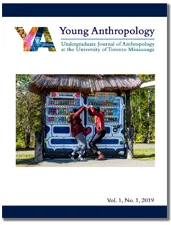

The inaugural issue of Young Anthropology, the peer-reviewed undergraduate Anthropology journal, is now published! The journal features articles, interviews, and reflection pieces.
This issue specifically features one of our very own alumni, Sukarmina Singh Shankar, titled The Benefit of Autopsies in Suspected Drug Overdose Cases, as seen in Nova Scotia, Canada. This article is based on Sukarmina's internship research project with the Nova Scotia Medical Examiner Service.
A sincere thanks goes out to everyone who contributed time and effort to this publication!
As a partner of the Anthropology Department, the Forensic Science Program wants to encourage students to submit articles, interviews, book reports, field reports and reflections in 2020. The deadline for submissions for the next issue will be May 31, 2020, but students can submit their pieces at any time.
You can find the journal under the Undergraduate tab of the anthropology departmental website, as well as the link below to the Young Anthropology journal page, where you can view the complete issue as a PDF file:
https://jps.library.utoronto.ca/index.php/ya/index.
Psychopathy Treatment and the Stigma of Yesterday's Research (Larsen 2019)

Dr. Rosenberg Larsen recently published an article in The Kennedy Institute of Ethics Journal entitled: "Psychopathy Treatment and The Stigma of Yesterday's Research". The editor Sandra L. Borden describes this contribution as challenging "the conventional wisdom of the medical establishment".
In his article, Dr. Rosenberg Larsen documents how psychopathy assessments are used to discriminate people from treatment and rehabilitation efforts, a medically erroneous practice allegedly rooted in a history of misleading research. Instead, he points to research suggesting that so-called psychopaths can gain from treatment/rehabilitation programs with similar success rates compared to non-psychopathic offenders.
Larsen, R. R. (2019). Psychopathy Treatment and the Stigma of Yesterday’s Research. Kennedy Institute of Ethics Journal 29(3), 243-272.
This article also figured as a chapter in a recent book publication by Routledge, "Ethics and Errors in Medicine": Larsen, R. R. (2019). “Psychopathy Treatment and the Stigma of Yesterday’s Research”. In Allhoff, F. and Borden, S. (eds.), Ethics and Error in Medicine. New York: Routledge. (Posted November 15, 2019)
Determining the Suitability of 3D Laser Scanning for Forensic Footwear (Rodrigues & Liscio 2019)
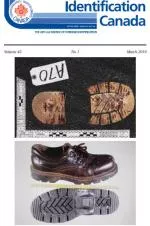
Footwear evidence is still highly valuable, and with the availability of 3D scanners capturing at high resolutions, there are some new approaches to how we interpret this kind of evidence.
FSC481 Internship student Charmaine Rodrigues recently published an article in Identification Canada (Journal for the Canadian Identification Society, Issue 42, No 1., March 2019), about how she and FSC406 instructor Eugene Liscio used a FARO Scan Arm to capture footwear impressions and subsequently analyze them in CloudCompare.
Instructor Liscio is a 3D forensic analyst, and the founder of AI2-3D. This research raised a lot of issues about how investigators treat this kind of data, problems encountered and ideas moving forward.
Identity informative SNP associations in the UK Biobank (Novroski 2019)
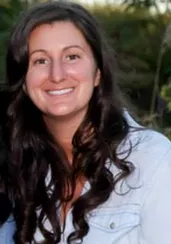
In September of 2019, Dr. Novroski presented at the International Symposium on Human Identification. Read all about her speaker feature Under the Microscope, in anticipation of her talk.
In addition, Dr. Novroski and colleague Frank Wendt have also recently published an article in Forensic Science International: Genetics:
Wendt, F.R., Novroski, N.M.M. (2019). Identity informative SNP associations in the UK Biobank. Forensic Science International: Genetics, 42:45-48. doi.org/10.1016/j.fsigen.2019.06.007
Dr. Novroski has also recently launched her biology laboratory website. Of special consideration is the opportunities page, for students who are interested in graduate work, undergraduate research, study participation. Visit the website for more information.
A Consideration of Carroll's Content Theory (Larsen 2019)

Dr. Rosenberg Larsen and colleague, Dr. David Sackris (Arapahoe Community College), recently published an article in The Journal of Value Inquiry critiquing a well-known philosophical theory that defines "aesthetic experience". David Sackris & Larsen, R. R. (2019). A Consideration of Carroll's Content Theory. The Journal of Value Inquiry, 1-13. doi.org/10.1007/s10790-019-09693-6
In addition, Dr. Rosenberg Larsen and colleague, Dr. Janna Hastings (University College London), recently presented a research project they have been working on for the past year at various conferences in Europe. In this work they propose a novel method to expand, standardize, and bring semantic coherence to the terminology used to describe symptoms in psychiatric diagnostics; a recurring problem in the attempt to facilitate accurate and reliable data annotation, as well as interdisciplinary research integration in mental health research. The project is titled: "Mapping the Patient's Experience: An Applied Ontological Framework for Phenomenological Psychopathology".
False-Positives in Psychopathy Assessment: Proposing Theory-Driven Exclusion Criteria in Research Sampling (Larsen 2018)

The Forensic Science Program is proud to have been an open source sponser of Forensic Psychology professor Dr. Larsen's latest publication: False-Positives in Psychopathy Assessment: Proposing Theory-Driven Exclusion Criteria in Research Sampling.
The method outlined in this paper is intended to be applied to psychology research sampling forensic science.
Click the citation below to be taken to the article:
Larsen R. 2018. False-Positives in Psychopathy Assessment: Proposing Theory-Driven Exclusion Criteria in Research Sampling. European Journal of Analytic Philosophy, 14:1.
Dr. Rosenberg-Larsen also recently published an article exploring improvements in psychopathy research, in terms of facilitating methods for better sampling:
Larsen R, Hastings J. 2018. From Affective Science to Psychiatric Disorder: Ontology as a Semantic Bridge. Front Psychiatry. 9:487.
